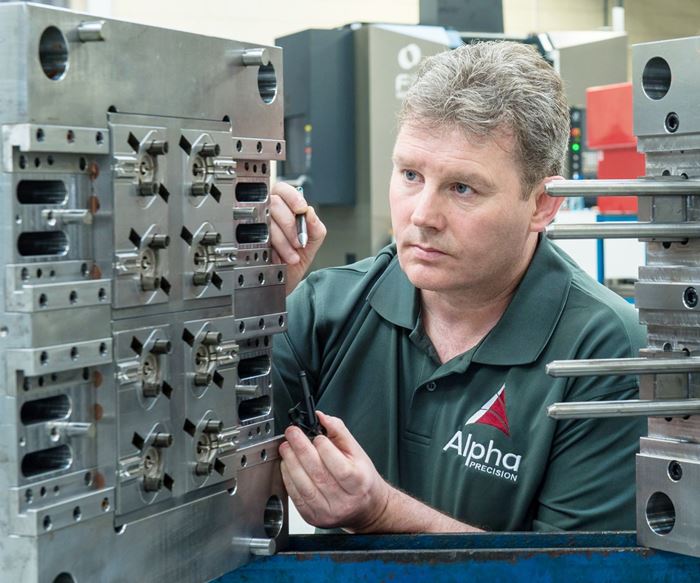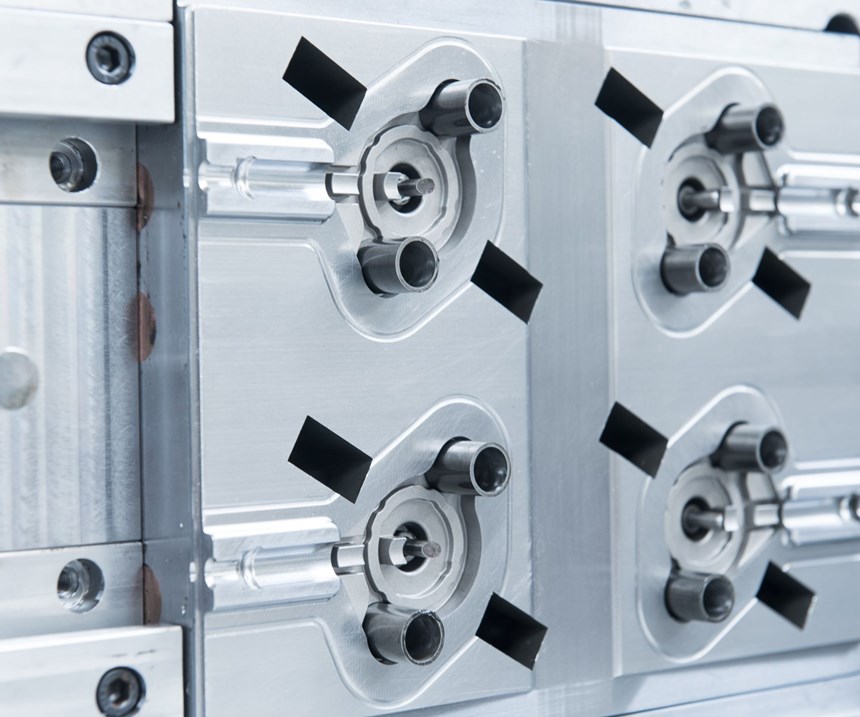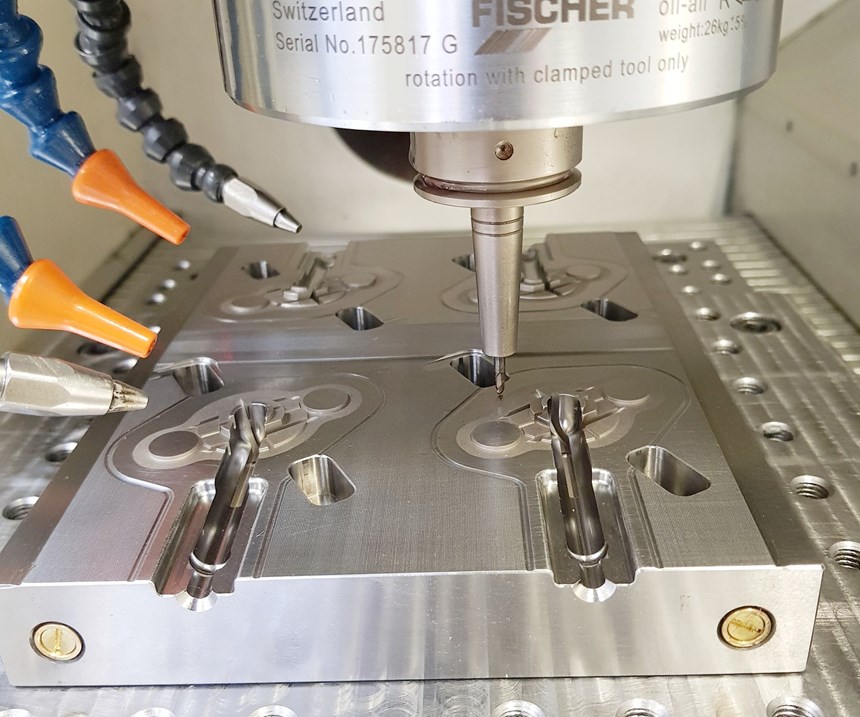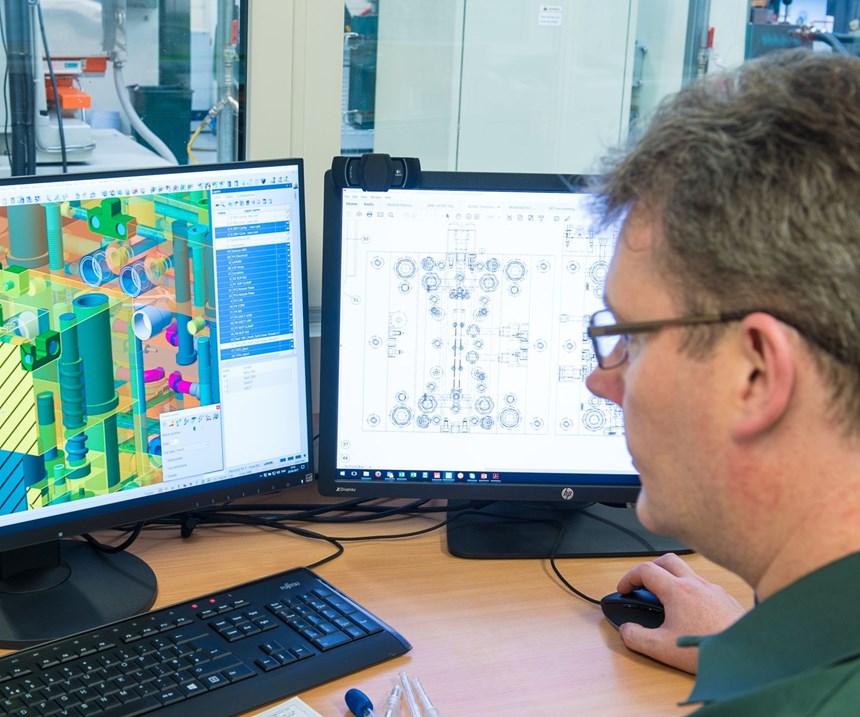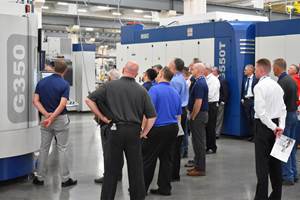CAD/CAM Platform Serves as a Communication Tool for a Moldmaker
CAD/CAM software for moldmaking became one company’s “universal translator,” smoothing communication and interoperability between client, designer, machinist and machine.
Share




Alpha Precision, an injection mold manufacturer, has been part of a recent resurgence of moldmaking in its native Irish Republic. Advanced die/mold software from Vero Software helped the company through the recession there by giving it a competitive edge to work in high-end markets.
“Several years ago, Ireland experienced an exodus of toolmaking contracts as work went overseas, particularly to China,” Director Brendan Feely says. “At the same time, the specialist Visi CAD/CAM software for the mold and die industry was rapidly developing and adding new features. Even companies which weren’t computer literate were investing in the technology to survive.”
Alpha Precision was founded in Tubbercurry in 1998 as a small, three-person shop with the intention of applying computerized manufacturing from the outset. According to Mr. Feely, this put the company ahead of many of its peers which seemed to be playing catch-up at the time. Still, the various departments in Alpha Precision’s shop were operating with different, incompatible tools. The designers used one kind of software to provide 2D drawings, and the moldmakers used another kind of software to translate these drawings into CNC programs for 3D parts. The translation process was time-consuming and prone to human error, as any translation tends to be.
To address this issue, the company now uses an almost full suite of Visi modules, which promotes a more automated production process. The CAD/CAM platform is composed of modules that can be acquired individually but are interoperable with each other, encompassing the process from modeling and design analysis to electrode design, CAM and enterprise-wide project management. According to Mr. Feely, operators only need to be trained in one particular Visi module, such as design, milling, wire and spark eroding.
On that note, Mr. Feely says that one of the selling points of the software was its user friendliness. It’s important to him that the software be easy to learn and use for everyone in the shop. Because Visi represents a significant investment, it would not be worth the hassle if it became a “piece of furniture” rather than a useful tool, he says.
For Alpha Precision, Visi serves as a vital communication tool, enabling designers, machinists and machines, who all speak different “native languages,” as it were, to share a common “second language” and communicate unimpeded. “One language is design, with others including flow analysis, milling, wire eroding and spark erosion. Visi is the common language that unites all processes, ensuring that everything moves fluidly through the toolroom from one discipline to another.” However, this is not where Visi’s strength as a communication tool ends, as will become clear.
Operating with 12 employees, the company produces approximately 40 molds per year, ranging in size from 100 by 100 by 100 mm to 600 by 1,000 mm, mainly for the automotive, medical, packaging and electronics industries. Two of its current projects include producing a number of high-cavitation tools for a medical customer and a contract for two-shot plastic-injection molds involving an overmold. “Although two-shot production adds another element by involving a second material and process, Visi keeps it simple and efficient,” Mr. Feely says.
With Visi programs guiding high-speed milling on Alpha Precision’s Röders and Makino F3 and F5 machining centers, the challenges posed by the medical industry’s ultra-fine-tolerance requirements are readily overcome. Electrodes are machined using the Makino F3, with high-definition machining performed with the F5. With Visi, the shop can machine in one night shift a cavity that would otherwise take a week. Visi also powers the company’s Charmilles spark-eroding machines and Mitsubishi wire EDMs. “Using Visi Machining, we can quickly produce a highly polished medical part with fine detail, a milled finish and a split line within micron accuracy,” Mr. Feely says.
Additionally, combining Visi’s Compass technology with its 2D- and 3D-milling capability means that all milling for hard prepping and high-speed finishing is handled quickly and accurately, which Mr. Feely says is vital to his operation. “We make a lot of one-off custom components for each mold, meaning we only run a program once. As pattern cutters, we need to be very good at generating CNC code time after time.”
Having invested in Visi’s Modeling, Analysis, Flow, Mold, Progress, Electrode, 2D Milling, 3D Milling and High Speed Milling, the software is used at every stage of Alpha Precision’s process, beginning with providing an accurate quotation for the customer.
And here is the rest of the “communication tool” picture. Before adopting Visi, making bids on jobs to potential customers involved presenting highly technical materials—2D drawings and schematics, for example—which might be understood by a select few, but not really make sense to stakeholders who might be more distant from the technical moldmaking and plastic-injection processes. Entering the job information into Visi to create a fully 3D visualization of the mold makes it much easier to communicate Alpha Precision’s bid to potential clients and also connects everyone’s idea of the finished product with a clear visual. The shop uses Visi’s analytical tools to check the drafts and all the different features it will need to build into a mold, such as the core and side pieces, and present this information clearly to the customer.
“When the order’s been placed, we work closely with our customer’s molders on the design concept, including flow analysis and tool layout. Once the 2D design is broken down and we have the tooling in full 3D, we really begin to see the huge power of Visi, which controls everything—from design to milling to wiring—in one environment.”
Thus, the software is a communications tool, a “universal translator” of sorts, for everyone involved in a given project. It smooths the entire production process from bid to finished product from one domain of knowledge and discourse to another, which adds to the system’s productivity benefits.
Related Content
Cimatron's Updated CAD/CAM Software Streamlines Mold Design
Eastec 2023: Cimatron V16 includes a clean new user interface and increased automation for faster mold design, electrode creation and NC programming.
Read MoreLyndex-Nikken Collets Enable Accurate Small-Diameter Cutting
The MMC Mini-Mini collet chuck is well suited for high-speed machining applications where clearance is needed, such as die mold, aerospace and medical parts.
Read MoreGrob Systems Inc. to Host Tech Event With Industry Partners
The 5-Axis Live technology event will highlight new machining strategies for optimizing the production of complex medical, aerospace and mold/die parts.
Read MoreIn Moldmaking, Mantle Process Addresses Lead Time and Talent Pool
A new process delivered through what looks like a standard machining center promises to streamline machining of injection mold cores and cavities and even answer the declining availability of toolmakers.
Read MoreRead Next
Setting Up the Building Blocks for a Digital Factory
Woodward Inc. spent over a year developing an API to connect machines to its digital factory. Caron Engineering’s MiConnect has cut most of this process while also granting the shop greater access to machine information.
Read More5 Rules of Thumb for Buying CNC Machine Tools
Use these tips to carefully plan your machine tool purchases and to avoid regretting your decision later.
Read MoreBuilding Out a Foundation for Student Machinists
Autodesk and Haas have teamed up to produce an introductory course for students that covers the basics of CAD, CAM and CNC while providing them with a portfolio part.
Read More
